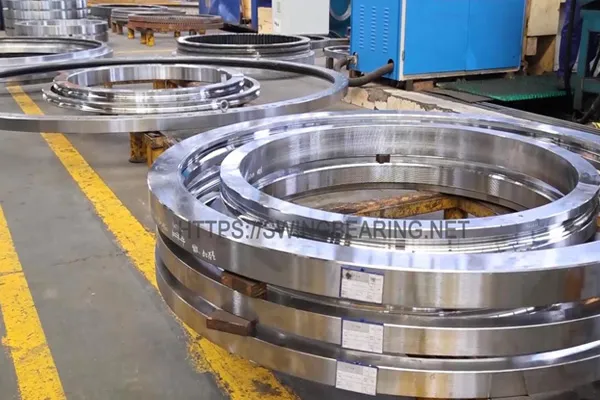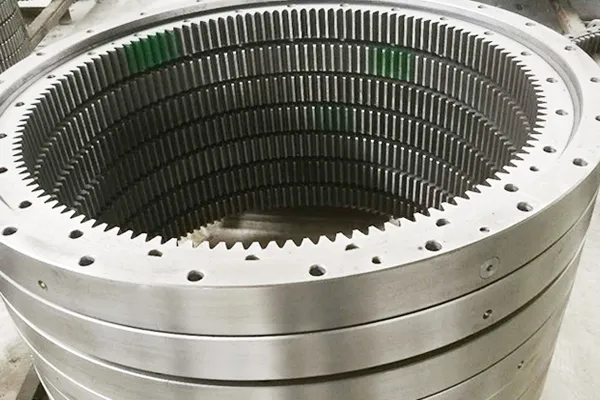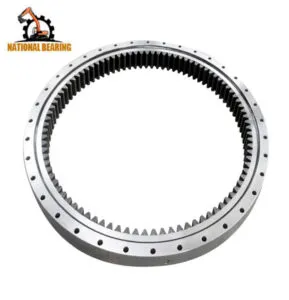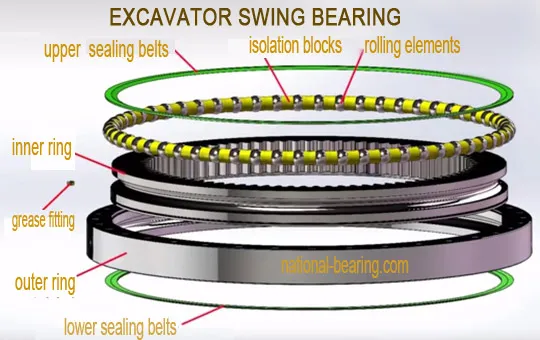
A rejtett erő leleplezése: A forgókarika helyének meghatározása egy kotrógépben
A forgókarika(a forgókarika), más néven lengőcsapágy( a kotrógépek kritikus alkatrésze. A kotrógép felső szerkezetének alján található, és lehetővé teszi a felső szerkezet forgását a futóműhöz képest. A lengőgyűrű felelős a felső szerkezet súlyának és az ásóerőknek a futóműre való átviteléért. Emellett lehetővé teszi, hogy a kotrógép oldalirányban lengjen.

Kotrógép forgókarika
A forgókarika, a crucial component in an excavator, plays a pivotal role in enabling the machine’s upper structure to rotate smoothly upon its lower structure. Understanding its location is essential for maintenance and repair purposes.
A lengőcsapágy jellemzően a kotrógép felső szerkezetének alján helyezkedik el, ahol az alsó szerkezettel érintkezik. Két koncentrikus gyűrűből áll, az egyik a felső szerkezethez, a másik az alsó szerkezethez van rögzítve. A gyűrűket gördülőelemek, például golyóscsapágyak vagy görgők választják el egymástól, amelyek megkönnyítik a forgást.
A lengőcsapágy helyének meghatározásához először is azonosítsa a kotrógép felső és alsó szerkezetét. A felső szerkezet az a rész, amelyben a fülke, a gém és a kar található, míg az alsó szerkezet a lánctalpakat vagy kerekeket és a futóművet foglalja magában.
Ha a felső és az alsó szerkezetet azonosítottuk, keressük meg azt a pontot, ahol összekapcsolódnak. Ez általában egy kör vagy hatszög alakú nyílás a felső szerkezet közepén. A forgógyűrű ebben a nyílásban található.
Egyes kotrógépeknél a lengőcsapágyat részben vagy teljesen védőházzal lehet körülvenni. Ez a ház arra szolgál, hogy a lengőkarika tisztán és kenve maradjon, meghosszabbítva ezzel az élettartamát. A forgógyűrűhöz való hozzáféréshez szükség lehet a ház eltávolítására.
A forgókarika elhelyezkedése az adott kotrógépmodelltől és gyártótól függően némileg változhat. Általában azonban a felső szerkezet alján található, ahol stabil és megbízható kapcsolatot biztosít a felső és az alsó szerkezet között.
A forgókarika helyének megértése kulcsfontosságú a karbantartási és javítási feladatok elvégzéséhez. A forgókarika rendszeres ellenőrzése és kenése elengedhetetlen a megfelelő működés biztosításához és az idő előtti kopás vagy meghibásodás megelőzéséhez. Ha a szakemberek tudják, hol található a forgókarika, akkor hatékonyan végezhetik el ezeket a feladatokat, maximalizálva a kotrógép teljesítményét és élettartamát.
A lengőcsapágy, amely egy kotrógép kulcsfontosságú alkatrésze, a felső szerkezet alján található, ahol az alsó szerkezethez csatlakozik. Ez a stratégiai elhelyezés lehetővé teszi a felső szerkezet zökkenőmentes és hatékony forgását, így a kotrógép a feladatok széles skáláját végezheti el.
A forgókarika két fő alkotóelemből áll: egy belső és egy külső fogaskerékből. A belső fogaskerék a felső szerkezethez van rögzítve, míg a külső fogaskerék az alsó szerkezethez van rögzítve. Amikor a kotrógép kezelője bekapcsolja a lengőmotort, a belső fogaskerék forog, meghajtja a külső fogaskereket, és a felső szerkezet elfordulását okozza.
The slew ring plays a vital role in the excavator’s functionality. It provides a stable and reliable connection between the upper and lower structures, ensuring smooth and precise rotation. Without a properly functioning slew ring, the excavator would be unable to perform its intended tasks effectively.
A forgókarika elhelyezése a felső szerkezet alján nemcsak praktikus, hanem előnyös is. Ez az elhelyezés lehetővé teszi a könnyű hozzáférést karbantartás és javítás során, minimalizálva az állásidőt és biztosítva a kotró folyamatos működését.
A forgókarika elsődleges funkciója mellett hozzájárul a kotrógép általános stabilitásához is. Azáltal, hogy szilárd kapcsolatot biztosít a felső és az alsó szerkezet között, segít egyenletesen elosztani a kotrógép súlyát, megakadályozva, hogy működés közben felboruljon.
Továbbá a forgókarika elhelyezkedése a felső szerkezet alján lehetővé teszi további alkatrészek, például hidraulikavezetékek és elektromos vezetékek beszerelését. Ezek az alkatrészek nélkülözhetetlenek a kotrógép működéséhez, és kényelmesen a forgókarikán keresztül vezethetők, biztosítva védelmüket és funkcionalitásukat.
Összefoglalva, a forgókarika egy kotrógép kritikus alkatrésze, amely a felső szerkezet alján helyezkedik el. Stratégiai elhelyezése lehetővé teszi a sima forgást, stabilitást biztosít, és megkönnyíti az alapvető alkatrészek beszerelését. A forgókarika funkciójának és fontosságának megértése alapvető fontosságú a kotrógép hatékony és megbízható működésének biztosításához.
The slewing ring is a vital component in an excavator, playing a pivotal role in enabling the upper structure to rotate smoothly upon the undercarriage. Understanding its location, structure, and function is essential for troubleshooting common issues related to this critical part. This detailed guide will help you identify, diagnose, and resolve problems associated with the slewing ring, ensuring your excavator operates efficiently.
The slewing ring is typically situated at the base of the excavator’s upper structure, where it interfaces with the lower frame. It comprises two concentric rings: one fixed to the upper structure and the other to the lower frame. Between these rings are rolling elements, such as ball bearings or rollers, that facilitate the rotation of the upper structure.
To access the slewing ring, it is necessary to remove the upper structure from the undercarriage. This involves several steps:
Once the upper structure is detached, the slewing ring becomes visible as a large, circular component located at the base of the upper frame.
The primary function of the slewing ring is to facilitate the rotation of the excavator’s upper structure relative to its undercarriage. This allows the operator to maneuver the boom, arm, and bucket with precision, enhancing the excavator’s versatility and efficiency. The slewing ring must withstand significant loads and stresses during operation, making its proper maintenance and functioning critical.
One of the most common issues with the slewing ring is excessive wear. This can result from various factors, including heavy usage, inadequate lubrication, and contamination. Symptoms of excessive wear include:
To diagnose excessive wear, perform the following checks:
If excessive wear is confirmed, take the following steps:
Proper lubrication is crucial for the smooth operation and longevity of the slewing ring. Inadequate or incorrect lubrication can lead to increased friction, overheating, and premature failure.
Signs of lubrication problems include:
To resolve lubrication issues:

Kotrógép forgócsapágy
Bearing failure in the slewing ring can have severe consequences, including total operational shutdown. This issue can be caused by various factors, including overloading, poor maintenance, and manufacturing defects.
Symptoms of bearing failure include:
If bearing failure is suspected:
Regular monitoring and maintenance are crucial for preventing issues with the slewing ring and ensuring its optimal performance.
Perform scheduled inspections to identify potential issues before they become severe:
Ensure that operators and maintenance personnel are adequately trained:
The slewing ring is a critical component of an excavator, enabling the upper structure to rotate smoothly upon the undercarriage. Understanding its location, structure, and function is essential for troubleshooting common issues and ensuring optimal performance. By regularly inspecting, maintaining, and addressing issues such as excessive wear, lubrication problems, and bearing failure, you can prolong the life of the slewing ring and enhance the overall efficiency and reliability of your excavator.
By following these detailed maintenance practices, you can ensure that your excavator’s hydraulic system remains in top condition, providing reliable performance and longevity. Regular monitoring, proper lubrication, and timely replacement of worn components are key to preventing common issues and maintaining the efficiency of the slewing ring.

A forgókarika szerkezete
1. Hol található a forgókarika egy kotrógépben?
- A forgókarika a kotrógép felső és alsó szerkezete között helyezkedik el.
2. Mi a feladata a forgókarikának egy kotrógépben?
- A forgógyűrű lehetővé teszi, hogy a kotró felső szerkezete az alsó szerkezethez képest elforduljon.
3. Milyen különböző típusú forgókarikákat használnak a kotrógépekben?
- A kotrógépekben használt forgókarikáknak két fő típusa van: golyóscsapágyas forgókarikák és görgőscsapágyas forgókarikák.
A lengőgyűrű, más néven lengőcsapágy, a kotrógép felső szerkezetének alján található fontos alkatrész. Támogatást nyújt, és lehetővé teszi, hogy a felső szerkezet simán forogjon az alsó szerkezeten, lehetővé téve, hogy a kotrógép precízen és hatékonyan végezze az ásási és földmunkákat.